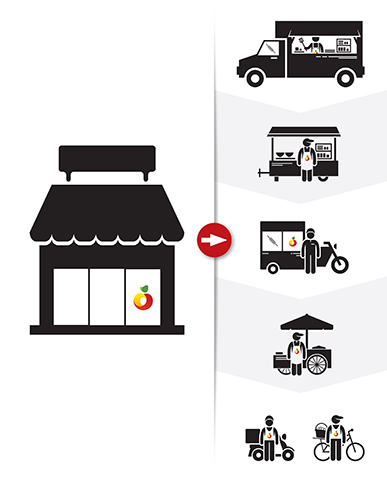 As discussed in the previous article, the menu offerings typically found in hotel restaurants, steakhouses, fast food restaurants and themed diners, are experiencing a “shaking” in the industry. Many restaurants, keeping in mind of the captive and semi-captive market, are starting to re-engineer their menus to catch up with the demands of profit and growth. Some investors, have particularly pushed for a “spin-off” strategy to improve their menu offerings.
As discussed in the previous article, the menu offerings typically found in hotel restaurants, steakhouses, fast food restaurants and themed diners, are experiencing a “shaking” in the industry. Many restaurants, keeping in mind of the captive and semi-captive market, are starting to re-engineer their menus to catch up with the demands of profit and growth. Some investors, have particularly pushed for a “spin-off” strategy to improve their menu offerings.
BRAND EXTENSION
The spin-off strategy is not new to the F&B industry. Also known as the “starburst” strategy, it is a type of brand extension that typically breaks up a business into separately owned parts. The primary purpose is to narrow the brand’s focus to its most profitable operations. The spin-off strategy is a cheaper way to enter a new category or sub-category rather than starting afresh in the menu category. Compared to launching a new category that requires name awareness at a high cost, starting with and extending through a wellknown brand can trim the expenses significantly.
LIVING EXAMPLES
There are several restaurants and food service establishments that have considered the brand extension strategy. Fiesta Restaurant Group is one of the food service establishment that perfectly spun off into two robust brands in scale and recognition – Taco Cabana and Pollo Tropical. Taco Cabana is an American fast casual restaurant chain specialising in Mexican cuisine, while Pollo Tropical is a restaurant chain and franchise specializing in the cuisine of the Caribbean. Both brands have outperformed the food service sector and guaranteed broader market returns to the Fiesta Restaurant Group, remaining as healthy home-grown brands with strong recognition in the markets they operate.

STRATEGIC CONSIDERATIONS
As you consider the spin-off strategy for your restaurant, bear in the mind that a successful spin-off comes from entering the right market, in the right manner, and at the right time. Allow these three questions to probe your preparedness to take up the spin-off strategy:
Is your present food service revenue stable?
Brand presence takes time to be built and restaurant owners should not overextend themselves in this brand extension strategy. During the stretch, spin from a position of stable revenues, and a solid financial strength coming from the core restaurant offerings to support the new stream until the extension reaches profitability.
Is your restaurant recognized by customers?
Keep in mind that spin-offs would only work when a large number of customers are aware of your restaurant services and your menu offerings.
Are you going too far from your core offerings?
Your primary menu offerings or restaurant brand can be affected when you go astray from what you specialise in, especially if it’s not of the same quality. Do not risk puzzling those who encounter your restaurant name – even the most strategic extensions can potentially dilute your restaurant name when there is too many of them.

THE REWARD
For restaurant owners who are placing their bets on this direction, here’s the good news – spin-offs, in general, could be an investment opportunity to beat the market. According to studies done on this strategy, companies that have successfully executed the spin-off strategy have outperformed other brands by at least 10 percent every year in the first three years of their independence. The parent companies also appear to perform well, with 6 percent outperformance each year. Indeed, the freedom attained from the release of a large corporate parent, combined with accountability and more direct incentives becomes an entrepreneurial force that drives company performance.
Although the spin-off strategy shows models of success in the F&B industry, ensure that your new menu platform is filling a gap for customers rather than jumping on the bandwagon concept plainly because it is trending in the industry. Do not allow changes to break up the rituals of customers that are intimately associated with your restaurant brand, and avoid any menu strategy that would cause a radical change in the value perception among customers. Not every trend is proven effective for menu offerings, and not every menu offering fits a particular concept.










